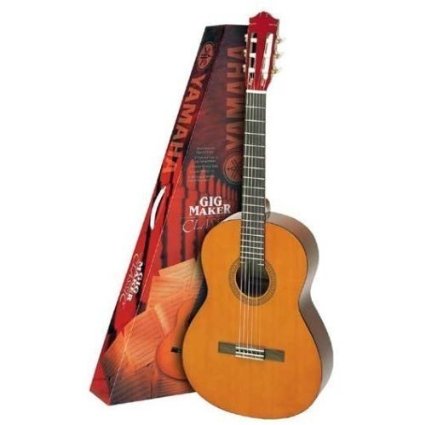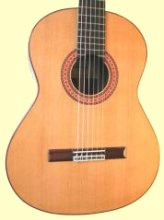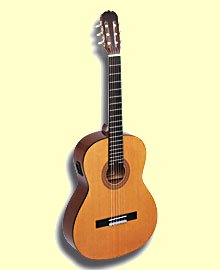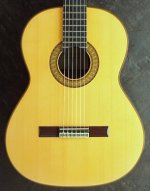Michael Hauser
Flamenco Guitar
Minnesota - a hotbed of flamenco? Michael Hauser, flamenco guitar player of repute lives and performs there. The north of the USA couldn't be more different from the home of flamenco in Spain, but Michael Hauser doesn't seem to mind shivering in those frilly shirts.
Masters of the flamenco guitar are a bit thin on the ground in the USA but Mr. Hauser appears to have carved out a unique niche for himself.
Flamenco Success Doesn't Come Easy
The classical guitar world's full of people, players, teachers and luthiers who's love of the music drives them on to work and perfect difficult skills with little public acclaim. Write a catchy three minute pop hit with three chords and nonsense lyrics and you can dine off it forever. Decide on a career in classical or flamenco guitar and it's a life of hard work just for the love of it.
Learning Flamenco Guitar From The Best!
The Michael Hauser flamenco guitar skills were honed under the tutelage of some of Spain's greatest flamenco guitarists, men like Luis Maravilla, Nino Ricardo, Justo de Badajoz and Juan Maya. He even studied classical guitar under Jesus Silva a pupil of Segovia - a bit like being being ordained by the Pope!
The Mark Of Zorongo
Along with his classical guitarist brother Tony, Michael has performed as the Hauser Guitar Duo. He's also completed many solo performances and appeared as first guitarist with a number of Spanish dance companies.
He's one of the founding members of the well known flamenco dance company, Zorongo Flamenco . Michael Hauser teaches flamenco guitar and he's on the faculty of Macalester College and the University of St. Thomas in St. Paul, Minnesota.
You can get more information about Michael Hauser, flamenco guitar player from his web site.
The Magic of the Flamenco Guitar
--Article Provided Courtesy of EzineArticles Author, David Woodford--
Flamenco is a popular style of Spanish Guitar Music. Flamenco has its own three forms which are Cante, Baile, and Guitarra. Cante is the song, Baile is the dance, and Guitarra is the guitar part of flamenco. Flamenco is a very important part of Spanish Guitar Music. It usually consists of someone playing the guitar, while people are dancing, and other people also join in with hand clapping. Although it is mostly popular in Spain, flamenco was influenced by other cultures as well.
Flamenco Guitar The Flamenco Guitar is very similar to the classical guitar. That is no surprise however, because flamenco music and classical music are very similar. Both of the instruments are descendants from the lute. The normal flamenco guitar is made out of the Spanish woods cypress and spruce. Even though this guitar is similar to a normal classical guitar, it isalso different. For example, the flamenco guitar weighs less and is smaller than a normal classical guitar. These features attribute to giving the flamenco guitar the sharp flamenco sound. Nearly all flamenco guitars come with a golpeador. The golpeador can be compared to a pick guard for classical guitar. They both have the same purpose-to protect the guitar. Because flamenco music has many different guitar playing techniques, it is important to have the golpeador. For example, there are several ways to strum the guitar for flamenco. Strumming is an easy way to scratch the body of the guitar, so a golpeador is needed. Also, besides strumming, the guitar still has many different styles of being played. For example, in flamenco, the musicians often use their hands and fingers and tap the body of their guitar to create sounds to blend in with the flamenco music. The hand and finger taps serve as another reason why a golpeador is needed.
History and Origin of Flamenco Flamenco appeared for the first time in literature in the mid 1770s. During the Golden Age of Spain, flamenco started to get more and more popular. Flamenco started becoming common in the country's music cafes. Also, around that time, the number of music cafes in Spain began to increase. As time progressed, flamenco began to get more and more serious. Other forms of flamenco started to generate, and many of them got deeper in meaning. During the early 1900s, flamenco singing started to get attention. Soon, full flamenco dances were taking place with the guitar, the singing, and the dancing. After 1915, many people started to have shows for flamenco, and musicians would play in front of a crowd at a theatre or another public place.
Popular Flamenco Guitarists Among the popular Flamenco Guitarists include: Juan Serrano, Vicente Amigo, Jesse Cook, Alex Fox, Gerhard Graf-Martinez, Oscar Herrero, Paco Peña, Ronald Radford, and many more.
Flamenco Today Today, flamenco is different than how it started. The dancers are mainly female, and they are showcased more. In the past, flamenco was more artistic, and the music and dance was the main focus. Now, flamenco usually consists of three parts. When there is multiple people dancing and the music is playing, the audience often joins in clapping. Today, the audience is also involved in flamenco.
To read a wealth of information about the guitar – how to play, what there is to play, and where to go for the best deals – go to David Woodford’s main site at http://www.info4u-services.com/Ultimate Guitar
Article Source: EzineArticles.com/?expert=David_Woodford
If you have a favorite guitarist you'd like me to feature here, please let me know. Send in reviews of concerts you've recently attended, and I'll include them on the site.
Return to Top: Michael Hauser Flamenco Guitar
Lost? Search Our Site!
Classical Guitars --- Spanish Guitar Makers --- Other Guitar Makers
Classical Guitar Players --- History of Classical Guitar --- Learn to Play Classical Guitar
Build Classical Guitars --- Guitar Making Schools --- Privacy Policy
Used Classical Guitars for Sale --- History of Classical Guitar







